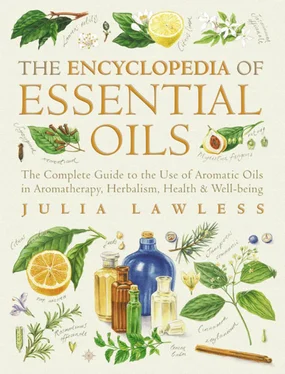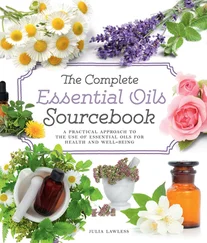CHARACTERISTICSColourless, pale yellow or reddish tinted liquid with an intense, sweet-woody, wintergreen-like scent.
PRINCIPAL CONSTITUENTSAlmost entirely methyl salicylate (98 per cent), produced during the maceration process. It is almost identical in composition to wintergreen oil.
SAFETY DATAMethyl salicylate, the major constituent, is not exactly toxic but very harmful in concentration.’ It can be absorbed through the skin, and fatal poisoning via this route has been reported.’ 12’ It is also classed as an enviromental hazard or marine pollutant.
AROMATHERAPY/HOME USENone.
OTHER USESLimited use as a counter-irritant in anti-arthritic and antineuralgic ointments and analgesic balms. Limited use as a fragrance component in cosmetics and perfumes; extensively used as a flavouring agent, especially ‘root beer’, chewing gum, toothpaste, etc. (usually very low-level use).
Betula alba
FAMILYBetulaceae
SYNONYMS B. alba var. pubescens, B. odorata, B. pendula , European white birch, silver birch.
GENERAL DESCRIPTIONDecorative tree, up to 15–20 metres high, with slender branches, silvery-white bark broken into scales, and light green oval leaves. The male catkins are 2–5 cms long, the female up to 15 cms long.
White Birch
DISTRIBUTIONNative to the northern hemisphere; found throughout Eastern Europe, Russia, Germany, Sweden, Finland, the Baltic coast, northern China and Japan.
OTHER SPECIESMany cultivars exist of this species of birch. The paper birch (B. papyrifera) and B. verrucosa are also used for the production of birch bud oil and/or birch tar. NB Should not be confused with the oil from the sweet birch (B. lenta) which is potentially toxic.
HERBAL/FOLK TRADITIONBirch buds were formerly used as a tonic in hair preparations. Birch tar is used in Europe for all types of chronic skin complaints: psoriasis, eczema, etc. In Scandinavia the young birch leaflets and twigs are bound into bundles and used in the sauna to tone the skin and promote the circulation. The sap is also tapped in the spring and drunk as a tonic. Buds, leaves and bark are used for ‘rheumatic and arthritic conditions, especially where kidney functions appear to need support … oedematous states; urinary infections and calculi.’ 13
ACTIONSAnti-inflammatory, antiseptic, cholagogue, diaphoretic, diuretic, febrifuge, tonic.
EXTRACTION1. Essential oil by steam distillation from the leaf-buds. 2. Crude birch tar is extracted by slow destructive distillation from the bark; this is subsequently steam distilled to yield a rectified birch tar oil.
CHARACTERISTICS1. Pale yellow, viscous oil with a woody-green balsamic scent. It crystallizes at low temperatures. 2. The crude tar is an almost black, thick oily mass. The rectified oil is a brownish-yellow, clear oily liquid with a smoky, tar-like, ‘Russian leather’ odour. It blends well with other woody and balsamic oils.
PRINCIPAL CONSTITUENTS1. Mainly betulenol and other sesquiterpenes. 2. In the tar oil: phenol, cresol, xylenol, guaiacol, creosol, pyrocatechol, pyrobetulin (which gives the ‘leather’ scent).
SAFETY DATANon-toxic, non-irritant, non-sensitizing.
AROMATHERAPY/HOME USE
Skin Care: Dermatitis, dull or congested skin, eczema, hair care, psoriasis etc.
Circulation Muscles And Joints: Accumulation of toxins, arthritis, cellulitis, muscular pain, obesity, oedema, poor circulation, rheumatism.
OTHER USESBirch bud oil is used primarily in hair tonics and shampoos, and in some cosmetics for its potential skin-healing effects. The crude tar is used in pharmaceutical preparations, ointments, lotions, etc. for dermatological diseases. It is also used in soap and leather manufacture – rectified birch tar oil provides the heart for many ‘leather’ type perfumes and aftershaves.
Peumus boldus
FAMILYMonimiaceae
SYNONYMS Boldu boldus , Boldoa fragrans , boldus, boldu.
GENERAL DESCRIPTIONAn evergreen shrub or small tree up to 6 metres high, with slender branches, sessile coarse leaves and bearing yellowish-green fruit; when dried the leaves turn a deep reddish-brown colour. The whole plant is aromatic.
DISTRIBUTIONNative to Chile; naturalized in the Mediterranean region. Some essential oil is produced in Nepal and Vietnam.
OTHER SPECIESThe Australian tree Monimia rotundifolia contains a similar oil, which has been used as a substitute. The oil of chenopodium or wormseed is also chemically related.
HERBAL/FOLK TRADITIONThe bark is used for tanning, the wood utilized in charcoal making and the fruit eaten by locals. In South America it has long been recognized as a valuable cure for gonorrhoea. In Western herbalism, the dried leaves are used for genito-urinary inflammation, gallstones, liver or gall bladder pain, cystitis and rheumatism. The dried leaves are current in the British Herbal Pharmacopoeia as a specific for cholelithiasis with pain.
ACTIONSAntiseptic, cholagogue, diaphoretic, diuretic, hepatic, sedative, tonic, urinary demulcent.
EXTRACTIONEssential oil by steam distillation of the leaves.
CHARACTERISTICSA yellow liquid with a powerful spicy-camphoraceous, disagreeable odour.
PRINCIPAL CONSTITUENTSCymene, ascaridole, cineol, linalol.
SAFETY DATAExtremely toxic. ‘The oil has powerful therapeutic effects, and it can be considered harmful to the human organism even when used in very small doses … should not be used in therapy, either internally or externally.’ 14
AROMATHERAPY/HOME USENone.
OTHER USESUsed in pharmaceuticals in minute amounts for its therapeutic properties.
Dryobalanops aromatica
FAMILYDipterocarpaceae
SYNONYMS D. camphora, Borneo camphor, East Indian camphor, Baros camphor, Sumatra camphor, Malayan camphor.
GENERAL DESCRIPTIONThe camphora tree grows to a great height, a majestic tree often over 25 metres high, with a thick trunk up to 2 metres in diameter. Borneol is a natural exudation found beneath the bark in crevices and fissures of some mature trees (about 1 per cent); young trees produce only a clear yellow liquid known as ‘liquid camphor’.
DISTRIBUTIONNative to Borneo and Sumatra.
OTHER SPECIESTo be distinguished from the Japanese or Formosa type of camphor, more commonly used in Europe, which is relatively toxic. See also Botanical Classificationsection.
HERBAL/FOLK TRADITIONBorneol has long been regarded as a panacea by many Eastern civilizations, especially in ancient Persia, India and China. It was used as a powerful remedy against plague and other infectious diseases, stomach and bowel complaints. In China it was also used for embalming purposes. ‘It is mentioned by Marco Polo in the thirteenth century and Camoens in 1571 who called it the “balsam of disease”.’ 15It is valued for ceremonial purposes in the east generally, and in China particularly for funeral rites. Its odour repels insects and ants, and it is therefore highly regarded as timber for the construction of buildings.
Читать дальше












